Riding the storm, getting the info
Published 12:33 pm Friday, June 1, 2018
By Lorenzo Salinas
The NOAA Gulfstream-IV and the U.S. Air Force Reserve WC-130J “Hurricane Hunter” are two of the planes used to track and record information about tropical cyclones.
Critical fact gathering
“These two planes, they’re critical to the National Hurricane Center in issuing forecasts and warnings,” Ken Graham, director of the NOAA National Hurricane Center, said.
For the WC-130J, pilots fly at 10,000 feet directly into the storm to collect data.
“They zigzag and get all sorts of information for us,” Graham said. “They drop this (gadget) and it looks at the hurricane, humidity, wind speed and pressure. It helps us feed the models. It’s basically our eyes.”
The NOAA plane charters a different course, and thereby collects different data.
“It goes higher. It can go to 40,000 feet and detect steering patterns, moisture content and basically helps get us environmental data in and around the hurricane,” Graham said.
“The two planes’ data feed into our models and, for us, the more accurate data they can get, the more accurate our forecast will be.”
Graham made sure to praise the men and women who pilot these planes, dubbing them “weather heroes.”
“These men and women risk their lives to get the data to keep people safe,” he said. “The dedication behind them is incredible… There’s no storm they won’t get into. They’re weather heroes.”
Getting technical
According to the NOAA website, the Gulfstream-IV (G-IV) is powered by twin engines — two fuselage mounted Rolls Royces Tay 611-8 twin spool turbofan jet engines. These give the G-IV a range of nearly 4,000 nautical miles and a cruising altitude of 45,000 feet.
It can house up to nine individuals, including pilots, engineers, meteorologists, mechanics, technicians and system operators.
To gather valuable intelligence on storm patterns and weather systems in the upper atmosphere, the crew of the G-IV drops a GPS dropwindsonde, a tube-shaped instrument, from the bottom of the plane. It collects data such as the pressure, temperature and humidity.
The WC-130J is part of a series of high-wing, medium-range aircraft used by the Air Force for weather reconnaissance missions.
Impressing the youth
If children’s impressions were anything to go by, Graham said he felt confident that the pilot and crew’s heroism (and the giant planes) did not go unnoticed by the kids who attended the 2018 NOAA Hurricane Awareness Tour in early May at Jack Brooks Regional Airport.
“Some of the comments I heard today were, ‘This is amazing! I saw the planes; I met the people.’”
Graham said this tour provided an excellent opportunity for people young and old to meet the experts and to ask them questions.
“I hope their takeaway is to look at all these people who are doing this (work) behind the scenes and remember,” Graham said. “My other hope is that these kids will be the next generation of meteorologists and hydrologists and experts who will replace us when we’re gone.”
Graham mentioned that getting the next generation excited about science was very important to the field as a whole.





